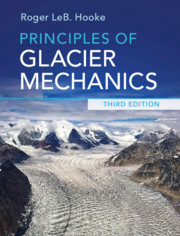Book contents
- Principles of Glacier Mechanics
- Reviews
- Principles of Glacier Mechanics
- Copyright page
- Dedication
- Contents
- Preface to the third edition
- Preface to the second edition
- Preface to the first edition
- Physical constants relevant to ice
- Derived SI units and conversion factors
- 1 Why study glaciers?
- 2 Some basic concepts
- 3 Mass balance
- 4 Flow and fracture of a crystalline material
- 5 The velocity field in a glacier
- 6 Temperature distribution in polar ice sheets
- 7 The coupling between a glacier and its bed
- 8 Water flow in and under glaciers: Geomorphic implications
- 9 Stress and deformation
- 10 Stress and velocity distribution in an idealized glacier
- 11 Numerical modeling
- 12 Applications of stress and deformation principles to classical problems
- 13 Ice streams and ice shelves
- 14 Finite strain and the origin of foliation
- 15 Response of glaciers to climate change
- 16 Ice core studies
- Problems
- References
- Index
5 - The velocity field in a glacier
Published online by Cambridge University Press: 20 December 2019
- Principles of Glacier Mechanics
- Reviews
- Principles of Glacier Mechanics
- Copyright page
- Dedication
- Contents
- Preface to the third edition
- Preface to the second edition
- Preface to the first edition
- Physical constants relevant to ice
- Derived SI units and conversion factors
- 1 Why study glaciers?
- 2 Some basic concepts
- 3 Mass balance
- 4 Flow and fracture of a crystalline material
- 5 The velocity field in a glacier
- 6 Temperature distribution in polar ice sheets
- 7 The coupling between a glacier and its bed
- 8 Water flow in and under glaciers: Geomorphic implications
- 9 Stress and deformation
- 10 Stress and velocity distribution in an idealized glacier
- 11 Numerical modeling
- 12 Applications of stress and deformation principles to classical problems
- 13 Ice streams and ice shelves
- 14 Finite strain and the origin of foliation
- 15 Response of glaciers to climate change
- 16 Ice core studies
- Problems
- References
- Index
Summary
In this chapter, a conservation of mass approach is used to develop a broad picture of the flow field in a glacier or ice sheet. Vertical velocities are shown to be downward in the accumulation area and upward in the ablation area, and horizontal velocities to increase with distance from the head of the glacier, reaching a maximum just below the equilibrium line. Conservation of momentum is then used to calculate the variation, with depth of horizontal and vertical velocity. Effects of valley sides and laterally non-uniform basal boundary conditions on the flow field are explored. Next patterns of internal reflectors imaged by radar are shown to reflect variations in effective strain rate and ice fabric. The reflectors can also be used to measure vertical strain rates and sub-ice shelf melt rates, and to document changes in the flow field over millennial time scales. Drifting snow also affects the flow field in polar environments, leading to development of narrow accumulation zones along the margin, and thus to formation of ice-cored moraines somewhat upglacier from the margin. Finally, inhomogeneous bed conditions beneath ice sheets can lead to streaming flow.
- Type
- Chapter
- Information
- Principles of Glacier Mechanics , pp. 81 - 114Publisher: Cambridge University PressPrint publication year: 2019
- 1
- Cited by



